
Mon Jan 17, 2006 4:54pm ET
Winds Halt Launch of Pluto Spacecraft
By MIKE SCHNEIDER, Associated Press Writer
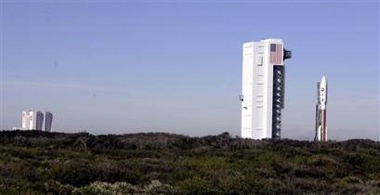
CAPE CANAVERAL, Fla. - High winds forced NASA to scrub the launch Tuesday of an unmanned spacecraft on a mission to Pluto, the solar system's last unexplored planet.
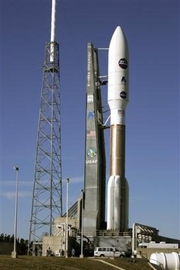 NASA planned to try again Wednesday to launch the New Horizons probe, although the forecast held a 40 percent chance of thunderstorms, clouds and gusty winds that could prevent a launch. NASA planned to try again Wednesday to launch the New Horizons probe, although the forecast held a 40 percent chance of thunderstorms, clouds and gusty winds that could prevent a launch.
A successful journey to Pluto would complete an exploration of the planets started by NASA in the early 1960s with unmanned missions to observe Mars, Mercury and Venus.
"What we know about Pluto today could fit on the back of a postage stamp," Colleen Hartman, a deputy associate administrator at NASA, said earlier. "The textbooks will be rewritten after this mission is completed."
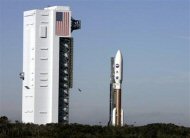 The launch also drew attention from opponents of nuclear power because the spacecraft is powered by 24 pounds of plutonium, whose natural radioactive decay will generate electricity for the probe's instruments. The launch also drew attention from opponents of nuclear power because the spacecraft is powered by 24 pounds of plutonium, whose natural radioactive decay will generate electricity for the probe's instruments.
Pluto is the only planet discovered by a U.S. citizen, though some astronomers dispute Pluto's right to be called a planet. It is an oddball icy dwarf unlike the rocky planets of Mercury, Venus, Earth and Mars and the gaseous planets of Jupiter, Saturn, Uranus and Neptune.
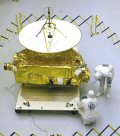 "My dad would be absolutely thrilled to see this," said Annette Tombaugh-Sitze, whose father, astronomer Clyde Tombaugh, discovered Pluto in 1930. "My dad would be absolutely thrilled to see this," said Annette Tombaugh-Sitze, whose father, astronomer Clyde Tombaugh, discovered Pluto in 1930.
Pluto is the brightest body in a zone of the solar system known as the Kuiper Belt, made up of thousands of icy, rocky objects, including tiny planets whose development was stunted by unknown causes. Scientists believe studying those "planetary embryos" can help them understand how planets were formed.
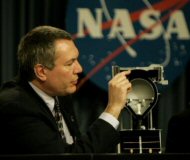 "Something, and we don't understand what ... stopped that process of growth and left us with this fantastic relic, this forensic evidence of planets that were arrested in the midstage of growth," said Alan Stern, the $700 million mission's principal investigator. "Something, and we don't understand what ... stopped that process of growth and left us with this fantastic relic, this forensic evidence of planets that were arrested in the midstage of growth," said Alan Stern, the $700 million mission's principal investigator.
An Atlas V rocket had been programed to speed New Horizons away from Earth at 36,000 mph, the fastest launch speed on record. Once launched, the craft will reach Earth's moon in about nine hours and arrive in 13 months at Jupiter, where it will use the giant planet's gravity as a slingshot, shaving five years off the 3-billion-mile trip.
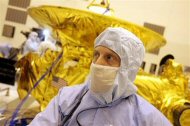 Some NASA safety managers had raised concerns about a rocket fuel tank since a similar test tank failed a factory pressure evaluation. The decision was made to fly since the flight tank was in pristine condition and had no signs of any defects like the ones found on the test tank, said NASA launch director Omar Baez. Some NASA safety managers had raised concerns about a rocket fuel tank since a similar test tank failed a factory pressure evaluation. The decision was made to fly since the flight tank was in pristine condition and had no signs of any defects like the ones found on the test tank, said NASA launch director Omar Baez.
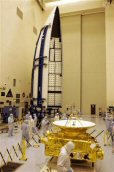 Thirty anti-nuclear protesters showed up recently to oppose this mission's plutonium-powered generator, compared to hundreds who protested the launch more than eight years of the Cassini mission to Saturn, which carried 72 pounds of plutonium. Thirty anti-nuclear protesters showed up recently to oppose this mission's plutonium-powered generator, compared to hundreds who protested the launch more than eight years of the Cassini mission to Saturn, which carried 72 pounds of plutonium.
The two Mars rovers, Spirit and Opportunity, sent up in 2003, had much smaller amounts of plutonium, which also was used on six Apollo flights.
NASA and the Department of Energy estimated the probability of a launch accident that could release plutonium at 1 in 350. As a precaution, the agencies brought in 16 mobile field teams that can detect radiation and 33 air samplers and monitors.
___
On the Net:
New Horizons Mission: http://pluto.jhuapl.edu
The Associated Press contributed to this report.
Copyright © 2006 The Associated Press. All rights reserved. The information contained in the AP News report may not be published, broadcast, rewritten or redistributed without the prior written authority of The Associated Press.
AviationHistory.org shall not be liable for any errors or delays in the content, or for any actions taken in reliance thereon.
|













 NASA planned to try again Wednesday to launch the New Horizons probe, although the forecast held a 40 percent chance of thunderstorms, clouds and gusty winds that could prevent a launch.
NASA planned to try again Wednesday to launch the New Horizons probe, although the forecast held a 40 percent chance of thunderstorms, clouds and gusty winds that could prevent a launch. The launch also drew attention from opponents of nuclear power because the spacecraft is powered by 24 pounds of plutonium, whose natural radioactive decay will generate electricity for the probe's instruments.
The launch also drew attention from opponents of nuclear power because the spacecraft is powered by 24 pounds of plutonium, whose natural radioactive decay will generate electricity for the probe's instruments. "My dad would be absolutely thrilled to see this," said Annette Tombaugh-Sitze, whose father, astronomer Clyde Tombaugh, discovered Pluto in 1930.
"My dad would be absolutely thrilled to see this," said Annette Tombaugh-Sitze, whose father, astronomer Clyde Tombaugh, discovered Pluto in 1930. "Something, and we don't understand what ... stopped that process of growth and left us with this fantastic relic, this forensic evidence of planets that were arrested in the midstage of growth," said Alan Stern, the $700 million mission's principal investigator.
"Something, and we don't understand what ... stopped that process of growth and left us with this fantastic relic, this forensic evidence of planets that were arrested in the midstage of growth," said Alan Stern, the $700 million mission's principal investigator. Some NASA safety managers had raised concerns about a rocket fuel tank since a similar test tank failed a factory pressure evaluation. The decision was made to fly since the flight tank was in pristine condition and had no signs of any defects like the ones found on the test tank, said NASA launch director Omar Baez.
Some NASA safety managers had raised concerns about a rocket fuel tank since a similar test tank failed a factory pressure evaluation. The decision was made to fly since the flight tank was in pristine condition and had no signs of any defects like the ones found on the test tank, said NASA launch director Omar Baez. Thirty anti-nuclear protesters showed up recently to oppose this mission's plutonium-powered generator, compared to hundreds who protested the launch more than eight years of the Cassini mission to Saturn, which carried 72 pounds of plutonium.
Thirty anti-nuclear protesters showed up recently to oppose this mission's plutonium-powered generator, compared to hundreds who protested the launch more than eight years of the Cassini mission to Saturn, which carried 72 pounds of plutonium.
